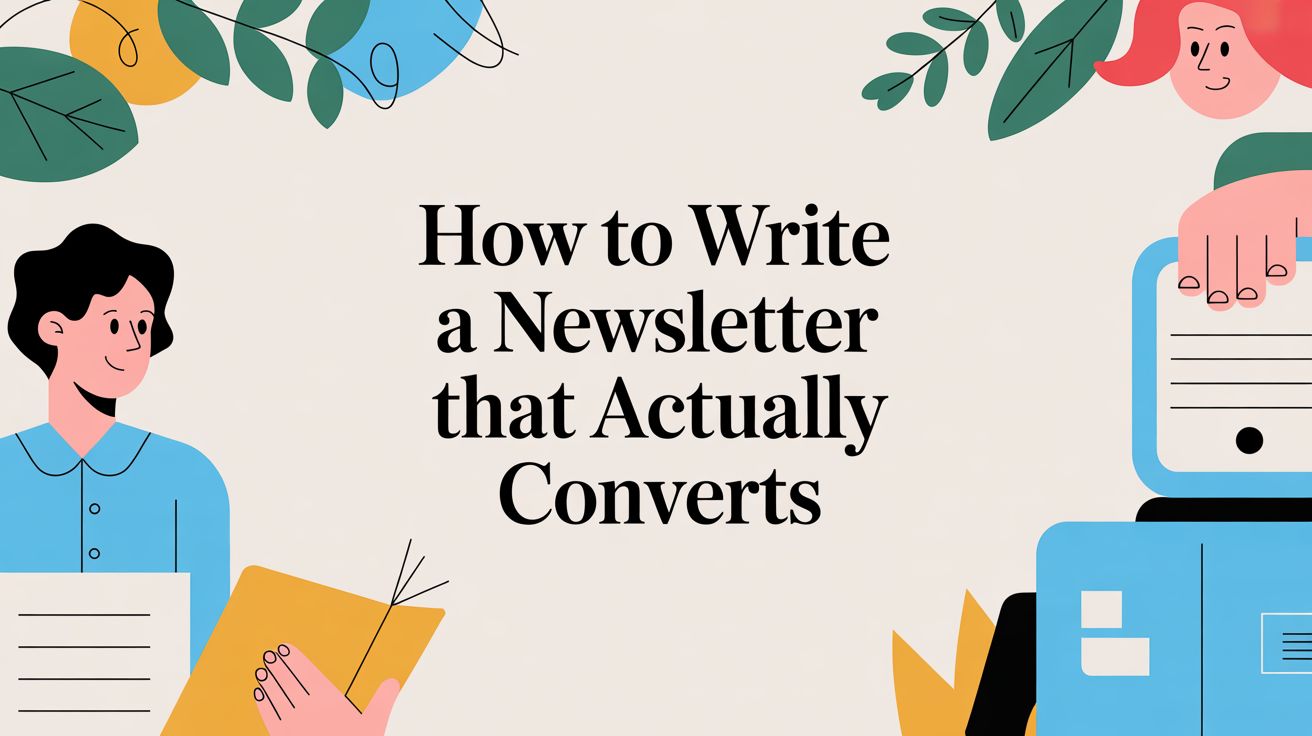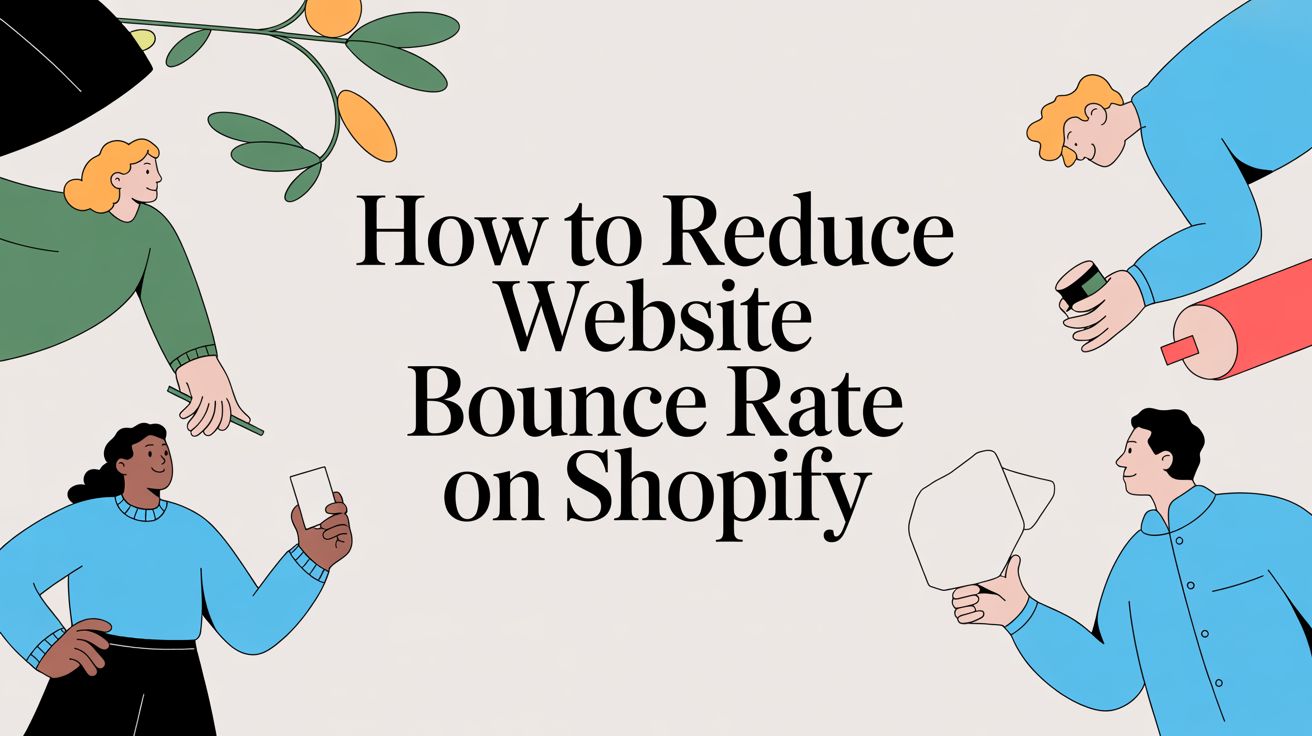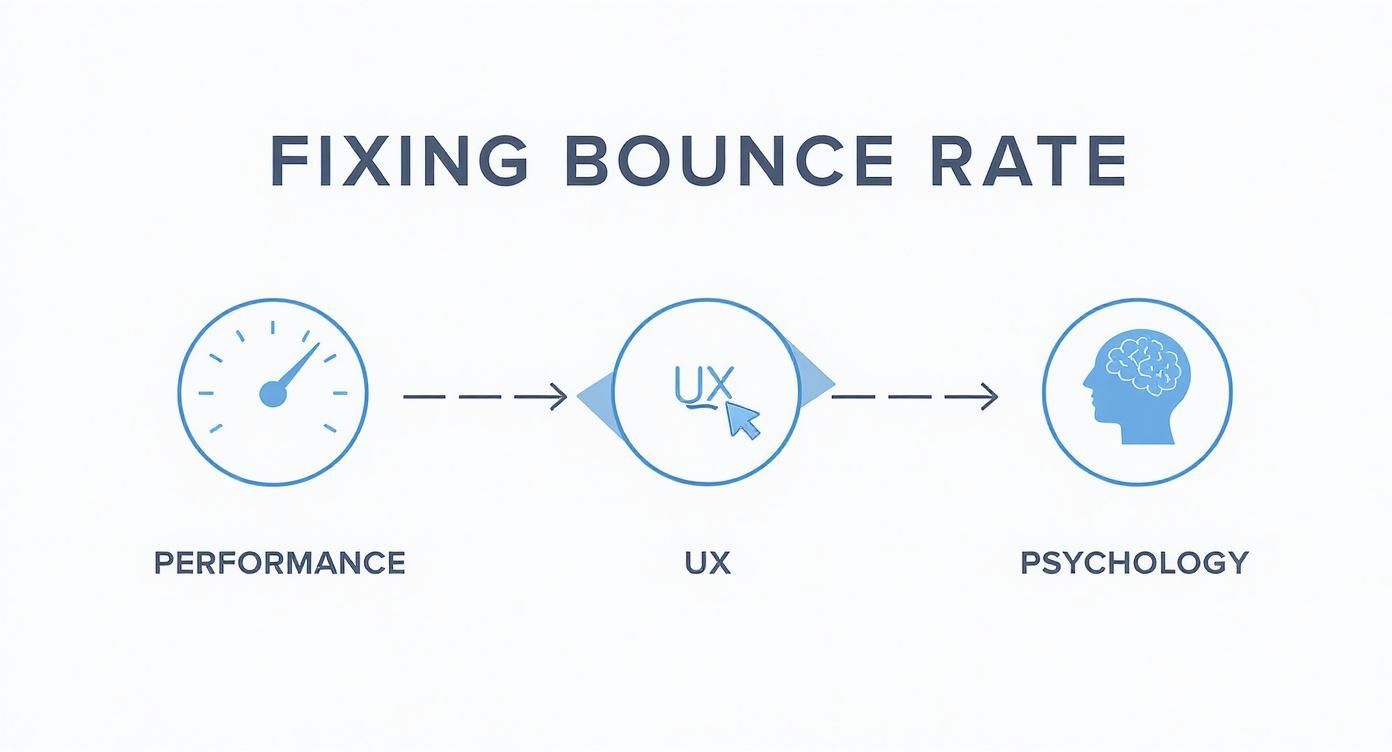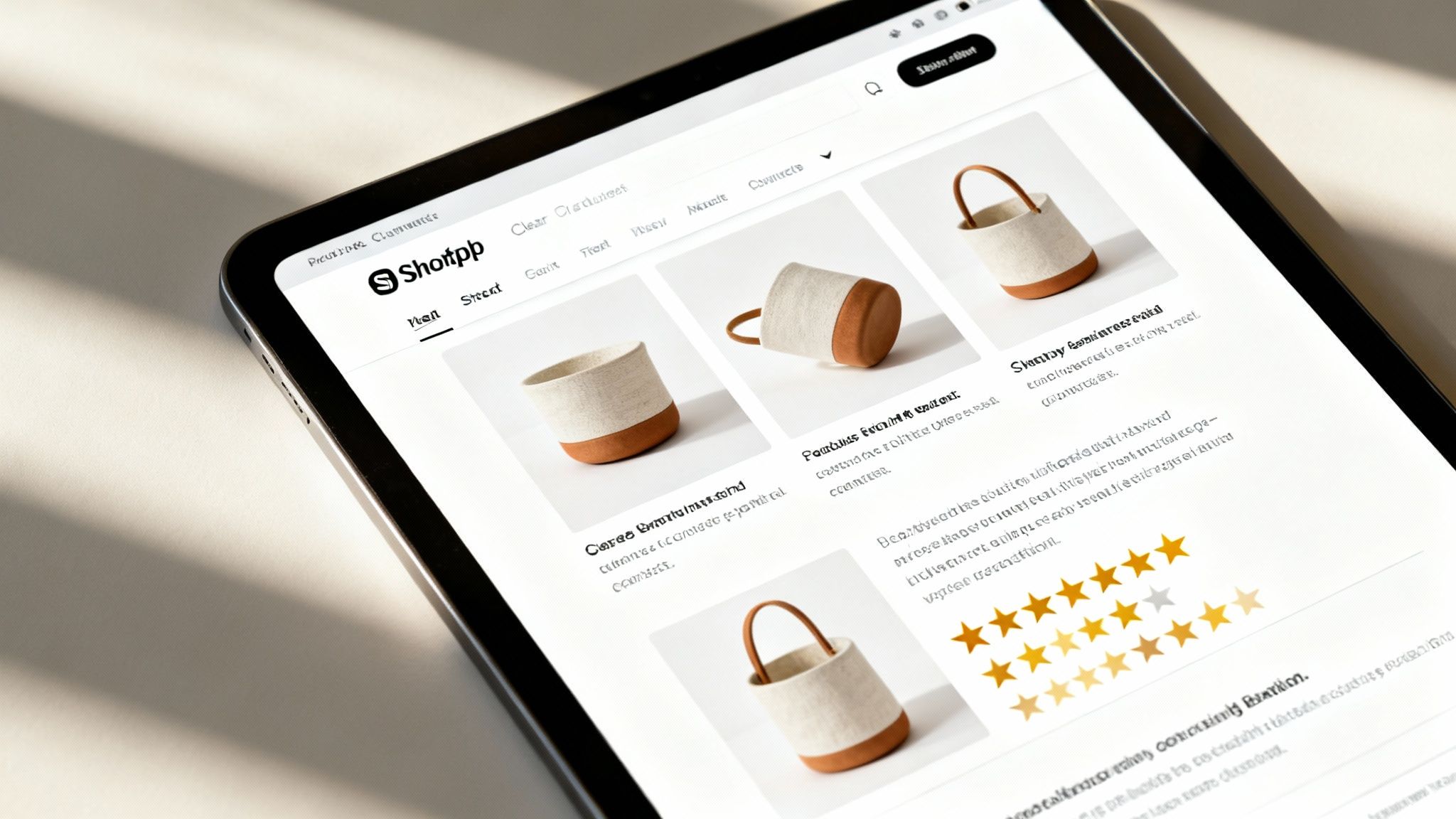
How to Reduce Website Bounce Rate on Shopify

If you want to reduce your Shopify store's bounce rate, you've got to look at the whole picture. It's a mix of fixing technical hiccups, smoothing out the on-site experience, and tapping into shopper psychology to keep people from clicking away.
This means getting your page speed up, making your navigation dead simple to use, and strategically using urgency marketing. The goal is to give shoppers a real reason to stick around your Shopify store instead of heading for the exit, directly impacting your ROI and inventory turnover.
Why a High Bounce Rate Is a Direct Hit to Your Revenue
Think of it this way: every single visitor who lands on your Shopify store and leaves without doing anything is a lost sale. A high bounce rate isn't just a vanity metric; it's a flashing red light signaling a direct hit to your revenue and a major inefficiency in your marketing spend.
For an e-commerce store, a "bounce" usually means someone hits a product or category page and then vanishes without clicking on another thing.
This isn't just a theoretical problem—it directly hurts your bottom line. It bloats your customer acquisition costs because you're burning through ad spend on traffic that doesn't convert. It also slows down inventory turnover, tying up your capital in unsold products. Addressing this is crucial for protecting your profit margins.
While every industry is a bit different, a lot of e-commerce sites see bounce rates somewhere between 20% and 45%. If you're seeing numbers higher than that, you have a significant opportunity to increase revenue without spending more on traffic.
The Three Pillars of Lowering Your Bounce Rate
Tackling this problem means focusing on three core areas: mastering the technical side of your site, elevating the user experience, and strategically using shopper psychology.
This isn't about randomly trying things. It's a logical, ROI-focused approach.

As you can see, it all starts with a solid technical foundation. A fast site is non-negotiable. From there, you layer on an intuitive design that makes shopping easy. Finally, you apply psychological triggers that encourage people to take action.
These pieces all work together to create an experience that makes visitors want to stay, browse, and ultimately buy. Dropping that bounce rate is a critical first step if you want to improve your Shopify conversion rate and squeeze more revenue out of the traffic you already have. Get these areas right, and you can start turning those quick visits into lasting customer relationships.
Fixing the Technical Glitches That Kill Conversions

Before a visitor ever gets a chance to fall in love with your products, your Shopify store has to work. Perfectly. And often, the number one reason people hit the "back" button is a slow-loading site. It’s the digital equivalent of a locked storefront—if customers can't get in the door fast, they'll just move on.
Improving your page load speed is probably the single most powerful lever you can pull to drop your bounce rate. The numbers don't lie: as page load time creeps from one second to ten, the probability of a visitor bouncing skyrockets by 123%.
Think about that. A site that loads in under two seconds can enjoy a bounce rate as low as 9%, but one that takes five seconds to appear often sees that number jump to 38%. These aren't just abstract IT metrics; they directly impact the return on your marketing spend and, ultimately, your bottom line.
Your Shopify Technical Audit Checklist
For Shopify merchants, thankfully, a lot of these technical gremlins are surprisingly straightforward to fix. A great first step is to run your store through a tool like Google PageSpeed Insights. It’ll give you a baseline score and a specific, actionable list of what's slowing you down.
From there, you can start knocking out the biggest offenders:
- Shrink Down Your Product Images: Huge, uncompressed images are the usual suspects behind a sluggish site. There are plenty of Shopify apps that can automatically compress your images without making them look grainy or pixelated. We've even put together a list of the most impactful apps for your Shopify store to help you get started.
- Pick a Speedy Theme: Not all Shopify themes are created equal. Some are sleek and fast, others are bloated and slow. Make sure your theme is optimized for performance and that the developers are still actively updating it.
- Nail the Mobile Experience: With most e-commerce traffic coming from phones, your site has to feel smooth and intuitive on a small screen. Don't just trust the theme's demo—pull out your own phone and go through the entire buying process. Find those friction points and fix them.
Technical performance is the bedrock of a good user experience. Even a one-second delay in mobile load times can slash your conversion rates by up to 20%. That's a direct hit to your revenue.
For Shopify store owners, focusing on site speed isn't just a "nice-to-have." It's a critical part of your conversion strategy. To get you started, here's a quick rundown of some high-impact fixes you can tackle right away.
High-Impact Technical Fixes for Shopify Stores
| Technical Issue | Impact on Bounce Rate | Actionable Shopify Solution |
|---|---|---|
| Large, Uncompressed Images | High | Use an app like TinyIMG or Crush.pics to automatically compress all product and theme images upon upload. |
| Slow Theme Code | High | Switch to a performance-focused theme like Dawn, or use a speed optimization app to clean up your current theme's code. |
| App Overload | Medium | Audit your installed apps. Remove any that are unused or redundant, as their scripts can slow down your storefront. |
| Lack of Lazy Loading | Medium | Implement lazy loading for images and videos, so they only load as the user scrolls down the page. Many modern themes have this built-in. |
These optimizations are your first line of defense against bounces. Once you’ve shored up the technical foundation of your store, you can move on to improving the user experience and content.
After all, one of the fastest ways to lose a potential customer is with a frustratingly slow website. Getting a handle on how to improve website loading speed is non-negotiable. By taking these steps, you ensure your site is ready to convert the traffic you’ve worked so hard to attract.
Crafting an Engaging On-Site User Experience

Alright, so your Shopify store is finally loading at lightning speed. That's a huge win, but it's only half the battle. A fast site stops people from leaving immediately, but a confusing or untrustworthy experience is the very next thing that will send them packing.
This is where you shift gears from preventing frustration to actively building desire.
For anyone running a Shopify store, this means thinking beyond the out-of-the-box theme. You need to map out a frictionless path from the second a visitor lands on your site to the moment they feel confident enough to buy. Think about it: logical navigation, clear product collections, and a search bar that actually works are the basics for helping shoppers find what they’re looking for without a headache.
There's a reason 65.4% of website redesigns are kicked off by high bounce rates. It’s a screaming signal that the user experience is broken. With e-commerce sites seeing an average bounce rate around 47%, it’s clear that a clunky on-site journey is a primary culprit.
Build Trust and Answer Questions Before They're Asked
Every single element on your product pages has a job to do: overcome skepticism. Your product descriptions need to go way beyond a simple feature list. They should anticipate every question a customer might have. What’s it made of? How does it fit? What problem is this really solving for me?
And visuals? They're non-negotiable.
You need high-quality photos from every conceivable angle, zoom features that show off the texture, and lifestyle videos that help shoppers imagine the product in their own lives.
Social proof is your ultimate trust signal. When you embed customer reviews, star ratings, and user-generated photos directly on your product pages, you give visitors unbiased validation. It builds instant credibility and stops them from bouncing to go read reviews somewhere else.
Truly understanding the importance of UX design in website conversions is what separates the stores that struggle from the ones that scale. By creating a seamless, trustworthy journey, you're not just selling a product; you're guiding a customer effortlessly from discovery to checkout. For a deeper dive, we’ve also put together an extensive guide on creating a website that converts packed with more actionable strategies.
Winning the Battle for Mobile Shoppers
It's no secret that mobile traffic dominates e-commerce. But here’s the catch: it also comes with a much higher bounce rate. A clunky, frustrating mobile journey is one of the fastest ways to kill a sale and inflate your bounce rate.
This makes a mobile-first design philosophy completely non-negotiable for any Shopify store aiming to actually convert that traffic.
Think about it. A shopper on a tiny screen has a totally different set of needs. Navigation has to be thumb-friendly. Buttons need to be big enough to tap without zooming. And checkout forms? They better be as simple as possible to minimize typing.
Anything from a poorly placed popup to a banner that blocks the view can cause an instant "I'm out of here." This is especially true for Shopify Plus merchants who are pulling in traffic from diverse sources and need every single conversion to count toward their bottom line.
Designing for the Mobile-First Shopper
Optimizing for mobile is so much more than just slapping on a responsive theme. It demands a real focus on the actual user experience.
- Simplify Navigation: Use menu labels that are crystal clear. Make sure your on-site search is front and center, because a visitor who can't find what they want in a few seconds is gone.
- Streamline Forms: Use address autocomplete and offer one-tap payment options like Shop Pay or Apple Pay. The less friction at checkout, the better.
- Test Everything: You have to regularly test your mobile site's speed and usability. A slow or confusing mobile journey is a direct cause of abandoned carts and high bounce rates.
Getting mobile right is a core strategy for slashing your bounce rate. The numbers don't lie: mobile bounce rates average a staggering 59.74% compared to 49.8% for desktops.
And consider this: 46% of users will ditch a site if a page takes more than 4 seconds to load. You can dig into more of these global website statistics to really grasp the impact.
A seamless mobile experience isn't just about stopping bounces. It's about protecting your profit margins and turning casual browsers into loyal customers.
Using Urgency Psychology to Keep Visitors Engaged
So you’ve tightened up your site’s performance and polished the user experience. What's next? The real magic in slashing your bounce rate lies in mastering shopper psychology.
This isn't about cheap tricks. It’s about applying proven behavioral science to give visitors a compelling reason to engage right now instead of clicking away. The goal is to short-circuit the bounce before it even happens by creating a genuine, in-the-moment sense of demand based on principles from consumer psychology and behavioral economics.
Too many Shopify apps just throw up a basic countdown timer and call it a day, but that barely scratches the surface. This approach contrasts sharply with sophisticated urgency marketing, which is grounded in the psychological principles that drive human action. It’s the difference between a generic timer and an intelligent system that understands where a shopper is in their journey.
By transforming key touchpoints with behavior-driven triggers, Quikly helps you dramatically lower bounces and turn fleeting interest into immediate revenue.
Beyond Timers: Intelligent Urgency Triggers
Sophisticated urgency marketing is about so much more than a simple pop-up begging for an email. It’s about creating dynamic "Moments" that actually protect your profit margins by encouraging full-price purchases and helping you clear inventory more efficiently.
Think about these powerful psychological levers:
- Scarcity: Grounded in the principle that we value what is rare, this tactic highlights limited availability to increase perceived value. Showing real-time stock levels like "Only 3 left in stock!" triggers a natural fear of missing out and pushes people to act.
- Social Proof: We are wired to follow the crowd. When you display a message like "25 people are viewing this now," you’re validating the product's popularity. It creates a sense of communal interest that makes visitors want to stick around and see what the fuss is about.
- FOMO (Fear Of Missing Out): This is the engine that powers every limited-time offer and exclusive drop. It taps directly into our aversion to loss, making the idea of missing a great deal feel more painful than the actual cost of the item.
By intelligently deploying these triggers through dynamic banners and pop-ups, you create a powerful narrative of demand. This isn't manipulation; it’s providing valuable context that helps shoppers make faster, more confident decisions, turning a potential bounce into a completed sale.
For Shopify merchants, plugging these psychological triggers into your site requires a platform that goes beyond clunky, manual campaign setups. We’ve built Quikly to specialize in the science of urgency, using sophisticated automation to deliver just the right message at the perfect moment. This approach, which can integrate with tools like Klaviyo and other SMS platforms, elevates the entire shopper journey, making engagement the most logical next step.
Your Top Bounce Rate Questions, Answered
Working with bounce rate can feel a bit technical, but figuring out what makes your visitors tick is key to growing your Shopify store's revenue. Let's tackle some of the most common questions merchants have.
What Is a Good Bounce Rate for a Shopify Store?
A good bounce rate for a Shopify store is the average rate at which visitors leave your site after viewing only one page. For most e-commerce sites, a bounce rate between 20% and 45% is considered healthy.
Of course, context is everything.
You’d want to see a much lower bounce rate on a product or category page because the whole point is to get people to click around and explore. On the other hand, a blog post or your "Contact Us" page will naturally have a higher bounce rate. If someone lands there, finds the one piece of information they needed, and leaves, they're not bouncing—they're satisfied.
The real goal isn't just a low number; it's evaluating whether the bounce rate makes sense for that specific page's purpose.
How Do I Track My Bounce Rate in Shopify?
This is a common point of confusion. Shopify itself doesn't actually have a native bounce rate report. To get this data, you have to connect your store to Google Analytics.
Once that's set up, you can see the bounce rate for your entire site, drill down into specific pages, and even see which traffic sources are sending visitors who stick around. If you're on Shopify Plus, you can integrate Google Analytics with other data tools to get an even clearer picture of where people are dropping off.
Does Bounce Rate Affect My SEO Rankings?
Yes, but it's an indirect relationship. Google has said they don't use bounce rate as a direct ranking signal, but don't let that fool you. A high bounce rate is often a huge red flag for a poor user experience, which absolutely hurts your SEO.
Think of it this way: when someone clicks on your site from a search result and immediately hits the back button, they're telling Google, "Nope, this wasn't what I was looking for." If that happens enough, search engines get the hint that your content doesn't match what people are searching for. Over time, that can definitely lead to lower rankings.
So, while you're not optimizing for a metric, you're improving the underlying user experience—which is a win for both your customers and your SEO.
Ready to turn bounces into revenue with the science of urgency? Quikly helps Shopify stores create intelligent, behavior-driven campaigns that keep shoppers engaged and drive conversions.

The Quikly Content Team brings together urgency marketing experts, consumer psychologists, and data analysts who've helped power promotional campaigns since 2012. Drawing from our platform's 70M+ consumer interactions and thousands of successful campaigns, we share evidence-based insights that help brands create promotions that convert.
